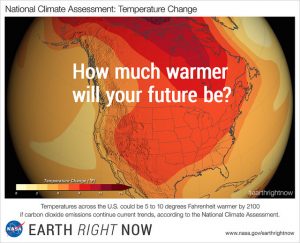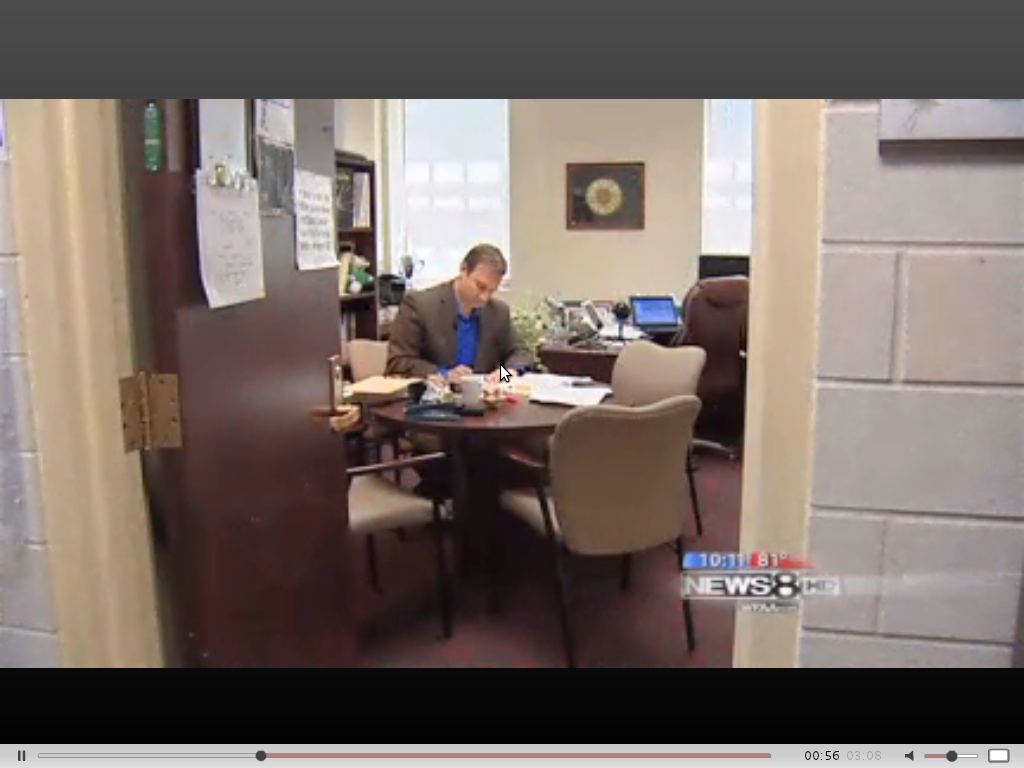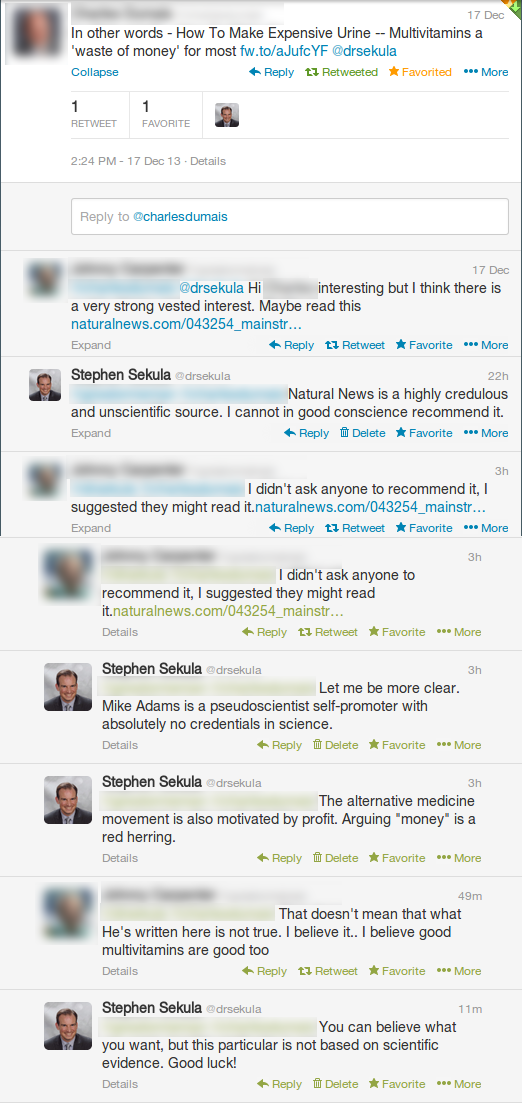
Scientific American recently published the responses they received from many US President Candidates regarding questions on science and scientific matters. In this post, I apply the skills we expect from the practice of good argument and scientific thinking to assess the questions and the responses.
Let’s focus on the “Research” and “Climate Change” questions for this round.
Research
The Question
The question put to the candidates was this:
Many scientific advances require long-term investment to fund research over a period of longer than the two, four, or six year terms that govern political cycles. In the current climate of budgetary constraints, what are your science and engineering research priorities and how will you balance short-term versus long-term funding? [1]
The question begins with the premise that scientific research requires a long-term vision for investment, and that this long-term vision may extend beyond the US political cycles (2 years, 4, years, 6 years). This is certainly the case. As an example from my own life, the Large Hadron Collider was conceived as a European project in the 1980s. US institutions became interested in joining the LHC as members of experiments or contributors to construction in the 1990s, after the collapse of the Superconducting Super-Collider project. The LHC was completed by 2008 and took its first physics data in 2010. This is a nearly 3 decade process, one that extended over multiple US Presidencies and many US Congresses!
However, in the US it is required by the Constitution that the Congress revisit the budget every year. This makes planning for more than 1 year quite challenging; nonetheless, federal agencies, congressional bodies, and the science community at large have learned to work with these constraints to mount long-term projects. This is not easy, but it has worked. It requires, at the very minimum, for the community and the government to set priorities for fields so that spending can be targeted, narrowly or broadly.
Then we get to the questions:
- What are the candidates’ priorities for science and engineering (research)
- How will they balance short-term needs and long-term funding needs?
Let’s see what the candidates said in response.
The Responses
The only responses to any of these questions came from Hillary Clinton (Democratic Party), Donald Trump (Republican Party), and Jill Stein (Green Party). In all cases, Gary Johnson (Libertarian Party) failed to turn in responses by the deadline.
Clinton’s response was the longest; Stein’s the next, and Trump’s only a single paragraph.
If you boil away the grand statements and platitudes from Clinton’s statement, her responses are this:
- “Advancing science and technology” will be among her highest priorities
- She is concerned that basic research spending by the federal government pales in comparison to other spending, despite its track record of returns.
- She would try to spend more money on young investigators; she would try to find ways to better support “high-risk, high-return” research proposals.
It’s pretty thin. “Advancing science and technology” doesn’t really say much about her specific priorities in federally funded research. For instance, she might have said “energy technology” or “new technology and medicine to fight migrating tropical diseases” or something a bit more narrow. This is vague. Vagueness can be a useful thing when it comes to scientific research; after all, nobody has a “crystal ball” and nobody knows which investigation will yield the biggest results (if we knew that already, science would just stop). So keeping it “vague but plausible” can be a strategy for how to spend money on research. But I personally would have expected a bit more specific targets, even if those targets are broad.
As for specific actions a President might take, finding ways to prioritize spending for new, young investigators is absolutely critical to avoid a brain drain in 30 years; but there is plenty more a President could do with priorities, and this is pretty thin as well.
What about Trump? His response, while short, can be further boiled down:
- The “space program” is a priority
- “Institutional research” is a priority (to incubate new ideas)
- He thinks bringing together stakeholders is important for setting priorities.
- Resource conservation, fighting hunger, and human health (even speaking globally) were named issues of importance.
For a single-paragraph answer, there is a lot going on. The impression that this response gives to a scientist is that Trump hasn’t a clear idea at all about how to answer this question. A bunch of possible priorities come tumbling out – space program, institutional research, resource conservation, fighting hunger, and human health – but there is no connective tissue. There is no planning, no vision, no thought. It’s just words. Clinton’s response was thin, but at least well-constructed. This is thin and random.
It also suggests that Trump has little to no idea how the process has worked. Stakeholders are already part of the process. In my own field, we meet every decade at meetings known as the “Snowmass Community Planning Meetings” and argue about the priorities for the next decade. This results in a set of recommendations from the community to the federal agencies, which they do try to take seriously and work with us to pare down to preserve the essentials. I am sure this doesn’t happen in all fields of research, but many do this; Trump seems uninformed about this.
What about Stein? Boiling down her response:
- Climate change is our greatest challenge.
- Top research priorities have to do with addressing climate change – e.g. mitigating greenhouse gases
- As President, she will make sure existing federal agencies like the NSF are operating as expected to serve research needs.
- She wants science to respond more to the needs of average citizens.
This may be the clearest and most targeted vision presented. It’s focused on a major issue (climate change), with a recognition that addressing it requires clear priorities (e.g. mitigating greenhouse gases – though what she means by that is unclear). Regarding federal funding agencies she seems focused on making sure their charges are appropriate. Certainly, making science responsive to the needs of citizens is important; after all, they pay for the research. However, it’s also important for a President to know that citizens, like all humans, cannot predict what things are useful in the future. For instance, when the electron was discovered by J. J. Thompson in 1897, it was called a “useless particle.” There is little doubt today that electricity, the control of electrons, is one of the most important things needed for humans to operate in society – fourth only to water, food, and sanitation. Useless things are not useless forever.
In Summary
Clinton and Trump fail to articulate a clear vision for science and engineering research priorities for their administrations. Clinton is vague, while Trump is specific but scatter-shot. Stein is the clearest of the three, focusing entirely on climate change (a major issue). Stein may misunderstand the importance of balancing relevance of research with the discovery of things that will be relevant in the future, but she’s brief enough that this is not clearly a problem in her thinking.
Climate Change
The Question
The question put to the candidates was this:
The Earth’s climate is changing and political discussion has become divided over both the science and the best response. What are your views on climate change, and how would your administration act on those views?[1]
The premise of the question is scientifically accurate, but also leaves out an important ingredient that is also scientifically established beyond any reasonable doubt. Indeed, the Earth’s climate is changing. But the question leaves out the knowledge that humans are the key ingredient in that change. I worry that they left this out, as if this knowledge is not knowledge. The fact that humans, through the burning of fossil fuels, are the key source of all of this change is essential to the logic that government, and policies made by governments, could be a key ingredient in dealing with it. If human caused it, humans can probably solve it.
But the question to the candidates is also broad and non-specific, so perhaps this level of vagueness was intentional. Perhaps the panel who composed the question kept it intentionally vague so as to prompt the candidates to speak freely, without having the issue framed. In that sense, perhaps this was a good question.
The question itself boils down to this:
- What are your views on climate change?
- How would your administration act on those views?
In the responses, we want to look for the following:
- Does the candidate state their views?
- Does the candidate quote established scientific evidence to back their views?
- What actions do they propose?
The Responses
The only responses to any of these questions came from Hillary Clinton (Democratic Party), Donald Trump (Republican Party), and Jill Stein (Green Party). Gary Johnson (Libertarian Party) failed to turn in responses by the deadline.
Stein’s response was the longest; Clinton’s was next, at about 2/3 or 3/4 the length of Stein’s; Trump’s was only a single paragraph.
Let’s look at Clinton’s response. She makes it very clear early on that there is no scientific doubt that climate change is happening. She doesn’t name the culprits (us), but since she then laser-focuses on controlling greenhouse gases she seems to hold the underlying belief that humans are responsible. Her primary action is to slash greenhouse gas emissions. She bullets a list of larger goals for her administration:
- Generate 50% of our electricity from non-fossil-fuel sources (she uses the term “green sources”, but she means what I wrote).
- She sets the very specific goal of a half-billion solar panel installations by the end of her administration.
- Cut domestic and manufacturing energy waste – one presumes she is speaking about energy efficiency here, but she is not specific.
- Reduce oil consumption by 30% and switch to fuels that, while combustable, produce fewer greenhouse gases per unit consumption.
She then discusses the means by which her administration would try to do this:
- Pollution and efficiency standards – build on the existing ones
- Provide tax incentives for switching to “cleaner” energy sources
- She closes with a very specific program proposal: “…launch a $60 billion Clean Energy Challenge to partner with those states, cities, and rural communities across the country that are ready to take the lead on clean energy and energy efficiency, giving them the flexibility, tools and resources they need to succeed.”
So Clinton provides very specific targets and some specific policies, including a spending program, to incentivise motion toward her goals.
What about Trump? In one paragraph, boiling it down to its essence, he says this:
- He casts doubt on the existence of climate change by putting the phase itself in quotes; he is the only of the three to do this, and this was intentionally added in his response since the question did not put this phrase in quotes.
- He seems to consider spending on this issue a waste of time, and instead suggests money should be spent on other things that all sound nice (clean water, diseases, food production) but have nothing to do with solving the issue of a human-made warming climate.
In short, he uses one paragraph to cast doubt on the existence of an established fact and then waves his hands to avoid having one paragraph be one sentence. There is no content in his response.
Let’s look at Stein’s response, the longest of the three. She immediately recognizes it as a threat – she is short and sweet on this point. Her specific policy actions:
- Enact the equivalent of a “New Deal” style federal policy, but aimed at development of jobs and technology to reduce the effect of climate change.
- Specifically, she aims to produce millions of new jobs based on this idea – but that’s about as specific as she gets… a target but not a clear plan.
- Spend more money on public transportation, sustainable agriculture, ecosystem restoration, etc. While the first of these can address greenhouse gases, the rest are mostly platitudes to her base that won’t affect climate change. Sustainable agriculture might be important for food supply, but doesn’t in any direct way address the problem that increased greenhouse gases cause the Earth to warm overall.
- Enact a program to transition workers from energy jobs of the current economy to those of the “new” economy.
- Make energy a human right by making energy systems owned by the community. This sounds like a plan to make energy more of a public utility, but it’s unclear what she’s doing here except to make a statement that likely appeals to her base.
- Redirect funds from fossil fuel energy profits to research in alternative energy sources.
- Change energy extraction procedures and redirect toward alternative sources that don’t involve those procedures.
- A comment here: clearly, she’s talking about ending practices like hydraulic fracturing. However, alternative energy sources like solar cells and even wind turbines involve the extraction of special minerals, especially rare heavy metals, from the Earth. There will always be the need to dig stuff out of the Earth to support energy technology. Focusing on overall reform for handling Earth extraction is probably wise, but it’s not solved by just switching away from fossil fuels.
- Support treaties and enforcement of climate treaty obligations
- Support organic farming and forestry practices
- Again, this has much less to do with addressing climate change and more to do with appealing to her base of support. More forests will certainly help take up more carbon dioxide from the air; can’t argue with that. But it really almost doesn’t matter how you achieve that – just plant more plants. Organic or otherwise, it’s the plant that matters and not so much the method of getting the plants in the ground. And, specifically, you want trees – trees lock up carbon for decades or longer. Perennial plants die and release the carbon back into the biosphere, which doesn’t solve the problem.
- More environmental justice laws
So Stein is the most specific of the three – she clearly is passionate about this issue. But some of her statements are misguided, more intended to appeal to the conservationist/environmentalist members of her base and less to actually address climate change, which is almost ENTIRELY about mitigating greenhouse gases yet to be put up in the air, or that are already in the air. Farming practices have a small, if any, effect on that; planting forests, altering the energy portfolio of the nation, or regulating industries that put up greenhouse gases are all more effective strategies. She lists these, but they are scattered in a mess of other things that don’t bear on climate change per se.
In Summary
Stein and Clinton have clear visions of the reality and danger of climate change. Trump doubts it exists, making his policy fantasy-based. Stein peppers in some good specifics among a nest of issues unrelated to climate change; this is clearly meant to speak to her base. Where Clinton and Stein focus on things related to the issue (transitioning the energy economy, supporting jobs, mitigating greenhouse gases) they are pretty much on target with the expected mix of government regulation and private action; Clinton seems to handle this mix better than Stein, who seems focused on government action.
[1] http://www.scientificamerican.com/article/what-do-the-presidential-candidates-know-about-science/




